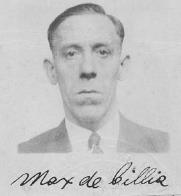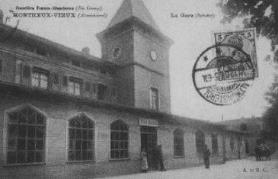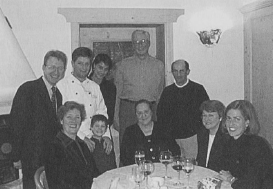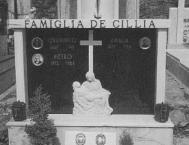My grandfather, Maximilian (Max) de Cillia, was the only member of his family to come to America. He came through Ellis Island in New York City just prior to World War I and on arrival told the U.S. Immigration authorities he was Swiss. He came here from Basel, Switzerland where he had been working as a fitter (schlosser). I have his Swiss Union card, issued exactly one century ago in 1907, when he was eighteen.

In reality however, Max de Cillia was German and had deserted the German Army by getting himself discharged as an "invalid" to come to America, probably in 1911 at the age of twenty-two. Apparently, out of fear he would be considered a criminal and deported, he never changed his story, so my father, and later my sister and I, grew up believing we were of Swiss descent.
As a kid, I was the only one who said I was Swiss. My neighborhood friends in the Bronx used to joke about me remaining neutral in everything. I actually began to believe this would be my role in life because of my perceived heritage. Honestly, I think it really affected my childhood personality development.
When I turned fifty in 1994, I developed an urge to learn more about my "Swiss heritage." My mother had given me some of Max's papers after my father died. She kept them because my father did not have a good relationship with his father and was not interested in his heritage. In fact, this father-son relationship was so poor that as soon as my father turned twenty-one he changed his first name from Maximilian to Henry! I've always been a bit disappointed that I could have been Maximilian de Cillia III, instead of Henry de Cillia Jr.
Upon examining Max's papers, I found a copy of his birth certificate, various union working papers, plus some letters and photos he had received over the years from two of his younger sisters. It didn't take too long to discover a German connection, mainly through the letters, some written in German, some in French. The dual language mystery resolved itself when I learned Max had been born in the Alsace-Lorraine region of France in a small village by the name of Montreux-Vieux (Alt-Munsterol in German), which was part of Germany at the time of his birth following its annexation at the end of the Franco-Prussian War in 1871.

France ("Alt-Munsterol" in German)
Max's father Franz Xaver worked for the German Customs Union (Zollverein) and was assigned to Alsace Lorraine right after the war. He had come from a small town, Straubing, in the Bavarian region of southeast Germany. In 1893, when Max was four years old, the family moved to Basel, because Franz Xaver had been promoted to a more important customs position there. So Max actually did grow up in Switzerland.
But this is only the preface to my de Cillia heritage discovery process.
Throughout my life, it has been obvious to me that de Cillia is an Italian name. Just about anyone who met me would say, "So, you're Italian," and I would say, "No, I'm Swiss," which led to the inevitable neutrality jokes. I eventually learned there was an Italian region in Switzerland, so I simply assumed Max was born there. But when I discovered the German connection and his birth in Alsace, my theory fell apart.
I began to research my German connection, especially in Bavaria where I knew my great-grandfather was born. I acquired some valuable information from the Straubing city archive, but their records only went back to the late 1800s. They directed me to the Catholic Church in the nearby Archdiocese of Regensburg where I corresponded with a Church archivist, Camilla Weber, who got me back to the early 1800s.
But the search stopped there once again until an amazingly serendipitous event occurred. One morning in May 1997, when my wife Pat was reading the Travel section of the Sunday New York Times, she came across an article entitled "Savoring Three Cultures" by Paul Hofmann, describing contiguous areas in Northeast Italy, Southeast Austria, and Slovenia that had more in common with each other than their own respective countries. In fact, they had even collectively and uniquely applied to host an upcoming Winter Olympics.
During his vacation in this area, Hofmann had stayed at a small inn in Tarvisio, Italy: Albergo Valle Verde, which was owned and operated by one Gianni de Cillia. Wow! I was literally floored to see my name in print in this context.
I need to mention how uncommon the de Cillia name is in the U.S. In searching the entire national telephone directory online, I have found only six other people with my last name – four from a single family living in Washington state. I had spoken with all of them by phone over the years, but none knew anything about their de Cillia heritage.
I sent a fax to Gianni de Cillia in Tarvisio inquiring about our shared last name and got a reply almost immediately from his wife Manuela because Gianni doesn't speak English. She told me Gianni was born in a small mountain village in northeast Italy called Treppo Carnico, where one third or more of the 500 residents had our name. I decided I needed to visit this place and we began planning a visit for 1999.
I called the de Cillia family in Washington State to reveal the news and coincidently learned they had booked a trip the same month to France, thinking they were French because their grandfather was born in Toulouse. They agreed to alter their trip and meet us in Tarvisio at the Valle Verde Inn so we could go to Treppo Carnico together.
Pat, our daughter Amy, and I, flew to Venice and drove up into the mountains to Tarvisio, the Italian equivalent of driving from New York to Vermont. This entire region is known as Friuli Venezia Giulia (or simply Friuli) and Tarvisio, like Treppo Carnico, is in Udine province, which is also the name of its major city. Within Friuli, Treppo Carnico is in the sub-region of the eastern Alps known as Carnia.

Author is standing in center, Chef Gianni
is in white coat, Buz, of Washington, is to
Henry's right, Henry's wife Pat is seated
left, and his daughter Amy is seated right.
The next three days were magical. We were treated like visiting royalty by everyone we met. On the first night, there was a private dinner at the Valle Verde, consisting of local cuisine prepared by Gianni, who is also the chef. Eleven people were present and we all had the same last name! The next morning we met Ferruchio de Cillia, Gianni's father, who took us on a wild ride to Treppo Carnico – weaving in and out of traffic, all the while cursing in Italian at every other car he passed. He didn't speak English either. This region is rarely visited by non-Italians. Moreover, the Italian dialect spoken in Friuli is not even understood by many native Italians. It has strong Germanic and Slavic influences due to its close proximity to Austria and Slovenia. As it turned out, Treppo Carnico is less than six miles from the Austrian border and less than twenty miles from Slovenia.
We met the mayor of Treppo Carnico, Luigi Cortolezzis, and presented what we knew about our families. Our travelling companions from Washington State, Buz and Sandy de Cillia, immediately connected Buz' family to the village, but we were not so lucky. We visited the Pinacoteca de Cillia (de Cillia Picture Gallery), where the paintings of the locally famous artist, Enrico (Henry) de Cillia, my namesake, are on display and were presented with a bound reproduction of his work. We had a wonderful lunch in the only restaurant at the Albergo Cristofoli, as Ferruchio drank at the bar with his friends. Then we met his mother in her tiny apartment with pictures of the Pope and JFK on the wall. She was quite flattered we came to see her. Our visit to Treppo Carnico was completed by walking through the village graveyard where every third headstone bears the family name de Cillia.
Returning home, I was elated to have learned so much, but still disappointed I was unable to make a personal connection to Treppo Carnico.

I decided to send an e-mail to Camilla Weber and tell her what I had learned in Italy. In looking at maps, Treppo Carnico is about 100 miles south of the towns in Bavaria where I now knew my family had lived, so I was more confident there was a connection to make. She agreed and told me that coincidently she was planning a vacation to Italy that would take her near Treppo Carnico, and offered to help – for a fee! She said she also spoke Italian fluently. After some wondering about whether this was a scam, I decided to send her the money and take my chances. How could I not put my faith in a Catholic Church archivist?
At least two months went by before I got a reply, but what a reply it was! She had made the connection. Here are some highlights of my Italian heritage that were provided by a priest in Paluzza (near Treppo Carnico) that Camilla met, Don Tarcisio Puntel, who is the local genealogist:
I am descended from Zuan de Zilia, who was born in Treppo Carnico in the late 1400s or early 1500s. (It was very hard to believe my lineage had been traced back more than 500 years at that point.) According to Father Puntel, my family name was taken from a female ancestor named Zilia (Cecilia).
One of Zuan's descendents, my great-great-great- grandfather, Peter de Cillia, was born in the Siaio section of Treppo Carnico on 6 June 1772 and migrated to Plattling, Bavaria, in the late 1790s. He married Katherina Wieshuber in Plattling on 19 February 1800.
Peter de Cillia was a merchant of unknown goods who would travel from Treppo Carnico to Venice (about 100 miles south) to purchase goods that he would later resell. Apparently, on one of his sales trips to Bavaria, he decided to stay.
So, I had learned my European family history took place in Friuli (now part of Italy), Bavaria (now part of Germany), Alsace Lorraine (once again part of France) and the city of Basel in Switzerland.
At this point, I had uncovered half a millennium of de Cillia family heritage in four different Central European countries that had undergone many political and boundary changes over the centuries. Many people may have been quite satisfied with these findings, but I wasn't. I still wanted to learn more about the derivation of my last name. If Father Puntel was right about his female ancestor theory, I wanted to find out who Zilia was. If Puntel wasn't right, I wanted to find the real source.
Having an unusual last name, I'll admit, lends itself to more effective genealogical research, especially in the age of the Internet. When I search my last name, I get a reasonable number of hits that can be reviewed easily. (In contrast, God only knows how many hits the last names Smith or Jones would uncover.) Every time I have searched my last name in recent years, there were many hits for a Rudolf de Cillia, who is a linguistics professor and prolific author. I discovered he taught at the University of Vienna, which published his email address, and decided to contact him to find out if he knew something about our shared last name.
He didn't respond immediately, but when he did I had another major revelation about my heritage, which has since been confirmed by other scholarly sources. The de Cillia name is taken from the city of Celje in Slovenia, which is called Cilli by German and Italian speaking peoples. It is an ancient city, first settled by the Celtic Veneti tribe and called Kelleia. Later, during the Roman Empire it was called Civitas Celeia, and during the Holy Roman Empire it was known as Zilli. In the 14th Century, the city was ruled by the Counts of Cilli who descended from the Lords of Zovnek in 1130.
It turns out the name of my family patriarch in Italy, Zuan de Zilia, simply means "John of Cilli." In fact, I have since learned that prior to Zuan's birth, few people even had last names so he may have actually been the first person in my family history to adopt one, other than the Counts of Cilli who ruled in the 14th and 15th centuries. But even they just used "of Cilli" to identify themselves.
This latest revelation has led me to research all things Slovenian. I have returned to the notions expressed in Hofmann's article "Savoring Three Cultures" about northeast Italy, southeast Austria, and Slovenia. However, these current national borders did not exist back in time and in reality, the three cultures were actually a single culture with Celtic, Romanic, Germanic, and possibly also Slavic roots. In fact, the first known settlers of this region, the Celtic Veneti Tribe, provided the most significant common roots. Many of the place names in the region, for example, Venice, Veneto, Friuli Venezia Julia and Slovenia, reflect this linguistic connection.
Of course, I have also been researching "John of Cilli" extensively on the Internet and have come up with one potentially enormous connection that is not yet confirmed. In the early 1400s, Frederick II, Count of Cilli, married Elisabeth of Frankopan and they had two sons, Ulrich II and Frederick III. But Frederick II also had an affair with Veronika (Veronica) of Desenice, later leaving his first wife Elisabeth and marrying Veronika. The love affair between Frederick II and Veronika is actually commemorated in Slovenian culture. During this period, however, Frederick II produced a third son, John, who is classified as illegitimate, probably meaning he was the son of Veronika before they married or perhaps a third unknown woman. John of Cilli was declared "legitimate" by the Pope in 1447, but I know nothing else about him.
Is it possible that this John of Cilli is actually Zuan de Zilia? The records from Treppo Carnico indicate Zuan was born there, but John's birthplace is unknown. As an illegitimate child, he probably would not have been prominent and he would not have inherited the title of Count. It is also possible that John of Cilli was Zuan's father because the time frame of mid to late 1400s would make sense. In either case, one of them may have been born in Treppo Carnico and become my "Italian" family patriarch.
If I can confirm my connection to the House of Cilli, I will add another nine generations and 350 years to my lineage because the Counts of Cilli are well documented. I've contacted Al Peterlin, Executive Director of the Slovenian Genealogy Society International, who has been kind enough to forward my request about John of Cilli to two well-respected Slovenian genealogists who may be able to confirm my theory, or provide me with a new one.
Now a fifth and possibly final European country has been added to my de Cillia family heritage. Maybe this latest Slovenian revelation will put my search to rest, but who knows? Another European trip is certainly in order and I have already named it the "Scattered Roots Tour." My dream would be to take a trip closely following the route that perhaps as many as twenty generations of my family travelled in Central Europe to migrate from Cilli: to Friuli, to Bavaria, to Alsace Lorraine, and finally to Basel, before Max de Cillia came to America.
While there surely will be more to find out, I have a wonderful sense of accomplishment for what I have learned so far. And, if anything, these feelings grow stronger as I get older. I have also gained a real appreciation of European history, especially as it explains the migration of my family from one place to another during critical periods in time. If my daughter Amy decides to start a family and has a boy, I've already asked her to name him Zuan.
Sources
-
Stadtarchiv Straubing, reported on 6 December 2000 that Max was discharged from the German Army on 1 August 1910. Assuming he emigrated quickly given his circumstances, he probably arrived here in early 1911. I have his citizenship certificate, but nothing about his arrival at Ellis Island.
-
I have my grandfather's birth certificate from Alt-Munsterol, which I later learned is the German name for Montreux-Vieux.
-
Stadtarchiv Straubing also reported on 6 December 2000 that my great grandfather Franz Xaver was promoted to his Basel customs position on 1 May, 1893.
-
From conversation with Manuela de Cillia in April 1999, and New York Times, "Savoring Three Cultures," Paul Hofmann, 11 May 1997, p. XX12.
-
Marriage record from the Stadtarchive Plattling, provided by Camilla Weber who visited the facility on author's behalf.
-
Berk, Sandi, "House of Cilli," Slovenian genealogical chart.
by Henry de Cillia Jr.
© 2011 The New York Genealogical and Biographical Society
All rights reserved.